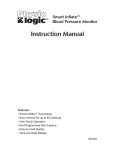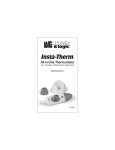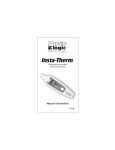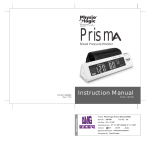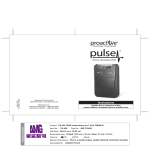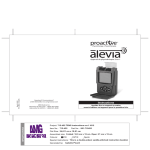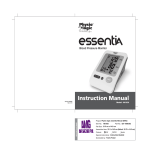Download AMG Medical Physio logic Specifications
Transcript
ys Table of Contents Important information . . . . . . . . . . . . . . . . . . . 3 ® Fuzzy Logic technology . . . . . . . . . . . . . . . . . 3 Statement of accuracy . . . . . . . . . . . . . . . . . . . 4 Now you know About blood pressure . . . . . . . . . . . . . . . . . . . 4 Blood pressure standard. . . . . . . . . . . . . . . . 4-5 Auto Arm Blood Pressure Monitor Featuring: • One-touch operation • 85 memories Blood pressure fluctuation . . . . . . . . . . . . . . . 5 Before taking a measurement . . . . . . . . . . . . . 6 Name / function of each part. . . . . . . . . . . . . . 7 Installing / replacing the batteries . . . . . . . . . . 7 Displays. . . . . . . . . . . . . . . . . . . . . . . . . . . . . . 8 To set the clock . . . . . . . . . . . . . . . . . . . . . . . . 9 To attach the cuff to the unit . . . . . . . . . . . . . . 9 To apply the cuff . . . . . . . . . . . . . . . . . . . . . . 10 Correct measuring posture . . . . . . . . . . . . . . 10 Taking a measurement. . . . . . . . . . . . . . . . . . 11 To recall memory . . . . . . . . . . . . . . . . . . . . . 12 To erase memory . . . . . . . . . . . . . . . . . . . 12-13 Troubleshooting . . . . . . . . . . . . . . . . . . . . . . 13 Cautionary notes . . . . . . . . . . . . . . . . . . . . . . 14 Specifications . . . . . . . . . . . . . . . . . . . . . . . . 15 Warranty . . . . . . . . . . . . . . . . . . . . . . . . . . . . 16 Instruction Manual For any question concerning this product, please call: 1-800-363-2381 www.amgphysiologic.com Model: 106-964 2 IMPORTANT INFORMATION Your physician's reading may sometimes differ from your home readings. This could be related to a phenomenon known as “white coat syndrome”. You should not assume that any one reading taken is your usual blood pressure. In fact, blood pressure varies constantly throughout the day. Common activities affect your level of heart activity and stress, thereby influencing your blood pressure. Statement of Accuracy Blood pressure measurements obtained with this unit are equivalent to those obtained by a trained person using the cuff/stethoscope auscultation method, within the limits prescribed by the American National Standard, Electronic or automated sphygmomanometers. About Blood Pressure Note: It is important that you take home readings regularly, and that you follow the procedures and precautions mentioned in the instruction manual. Consistently recording/charting your readings, along with regularly consulting a health professional, is an important aspect of your overall blood pressure management program. Blood pressure is the pressure exerted by the blood at right angles to the walls of the blood vessels, while blood flows through the arteries. The pressure measured when the heart contracts and sends blood out of the heart is called systolic; it is the peak pressure in the arteries during the cardiac cycle. The pressure measured when the heart dilates with blood flowing back into the heart is called diastolic; it is the lowest pressure at the resting phase of the cardiac cycle. This Blood Pressure Monitor does not replace examination by a physician. As your doctor is the one person best qualified to interpret your results, we recommend that you keep a blood pressure journal to bring to your visits to your healthcare professional. High blood pressure’s strong correlation with cardiovascular diseases and high morbidity has made measuring blood pressure a necessity of identifying those at risk. Fuzzy Logic Technology This Physio Logic® monitor uses the oscillometric method to detect your blood pressure. Before the cuff starts inflating, the device will establish a baseline cuff pressure equivalent to the air pressure. Your Physio Logic® monitor will determine the appropriate inflation level based on one's pressure oscillations, followed by cuff deflation. During the deflation, the device will detect the amplitude and slope of the pressure oscillations and thereby determine the systolic, diastolic, and pulse for you. 3 Blood Pressure Standard The World Health Organization (WHO) and the National High Blood Pressure Education Program Coordinating Committee have developed a blood pressure standard, in which areas of low and high risk blood pressure are identified. This standard is a guideline as blood pressure varies among different people and different age groups. It is important that you consult with your physician regularly. Your physician will tell you your normal blood pressure range as well as the point at which you will be considered at risk. 4 Blood Pressure Standard Before taking a measurement Blood Pressure for Adults Age 18 and Older To help you obtain more accurate readings: • Urinate if necessary. • Remove any clothing and jewellery from your left arm. Placing the cuff on anything other than bare skin can result in an inaccurate reading. • Sit in a comfortable position with your legs and ankles uncrossed and your back supported. • Sit quietly for 15 minutes before measuring your blood pressure. • If you need to retake a reading, wait at least 5 minutes to allow your circulation to return to normal. • Pick a time of day, and take your blood pressure at about the same time every day. Since your blood pressure varies at different times of the day, this will make it easier for you to compare your daily blood pressure readings. A good time to take your blood pressure is in the morning, before breakfast. • Don't smoke, eat or exercise for 30 minutes before taking your blood pressure. These activities can change your blood pressure. • Do not measure your blood pressure immediately after consuming a large meal. To obtain more accurate readings, please wait one hour before measuring. • Only take your blood pressure in a quiet place and when you are relaxed. Don't take your blood pressure when you are under stress. Any stress will raise your blood pressure. • Position your arm so that the cuff is at the level of your heart. • If the monitor is stored at very low temperature (near freezing), place it in a warm location for at least one hour before using it. Category Systolic (mmHg) Stage 2 Hypertension Stage 1 Hypertension Prehypertension Normal ³ 160 140-159 120-139 < 120 Diastolic (mmHg) or or or and ³ 100 90-99 80-89 < 80 Blood Pressure Fluctuation Blood pressure fluctuates all the time! You should not be overly worried if you encounter two or three measurements at high levels. Blood pressure changes over the month and throughout the day. It is also influenced by season and temperature. (Case: Male, 35 years old) Systolic 150 mmHg 100 Diastolic 50 Wake Arrive Telephone Argument Leave up office Discussion in a meeting office 6:00 18:00 12:00 Dinner / Sleep Midnight The following factors will influence blood pressure and cause variations in your measurement results: • • • • • • Bathing Talking Exercise Feeling tense Thoughts Smoking • • • • • • Breathing Drinking alcohol Moving Eating Changes in temperature Etc. 5 6 Name / Function of Each Part Displays Low Battery Indicator Systolic Clock Diastolic Cuff Signal Output Port LCD Screen Pulse Memory Memory Button Start / Stop The pressure measured was lower than 20 mmHg. Measure again quietly. Installing / Replacing the Batteries 1. Slide out the battery cover. The pressure measured was higher than 300 mmHg. Measure again quietly. 2. Install 4 “AA” batteries, being careful to respect the polarities (+ and -). 3. Slide back the battery cover. Pumping error. Verify that the cuff is properly applied and measure again. • Replace all batteries if the low battery indicator appears. • Remove the batteries if the unit will not be used for a long period of time. Pressure cannot be measured due to signal noise. Measure again. • It is recommended to use the same type of alkaline batteries to avoid incompatibility. Pumping pressure exceeds 300 mmHg. Measure again. or no display 7 Low battery. Verify that the batteries are in place and replace them if necessary. 8 To set the clock 1. To enter clock setting mode, press and hold the MEMORY button for three (3) seconds. 2. The display will show a blinking year. To set the year, press the START/STOP button repeatedly until the desired value is reached. To apply the cuff 1. Clothing sleeves should be rolled up and the cuff should be wrapped on bare skin for correct measurements. 2. Apply cuff to the left upper arm. 3. Fasten the cuff, making sure it is snug but not too tight. Ensure that the edge of the cuff is approx. 1” (2.5 cm) from the crook of your arm, as illustrated. 1”(2.5 cm) 3. Press the MEMORY button again to adjust the month and use the START/STOP button to adjust the value. Repeat this step again to set the day, hour and minute. 4. If your physician has diagnosed you with poor circulation in your left arm, carefully place the cuff around your right arm. Correct Measuring Posture To attach the cuff to the unit Connect the tube to the socket at the back of the unit. 9 1. Place your elbow on a table so that the cuff is at the same level as your heart. If needed, use a soft object such as a folded towel to support your forearm in a proper position. Turn your palm upwards, sit upright in a chair, and take 5-6 deep breaths. Avoid leaning back. 10 To set the clock 1. To enter clock setting mode, press and hold the MEMORY button for three (3) seconds. 2. The display will show a blinking year. To set the year, press the START/STOP button repeatedly until the desired value is reached. To apply the cuff 1. Clothing sleeves should be rolled up and the cuff should be wrapped on bare skin for correct measurements. 2. Apply cuff to the left upper arm. 3. Fasten the cuff, making sure it is snug but not too tight. Ensure that the edge of the cuff is approx. 1” (2.5 cm) from the crook of your arm, as illustrated. 1”(2.5 cm) 3. Press the MEMORY button again to adjust the month and use the START/STOP button to adjust the value. Repeat this step again to set the day, hour and minute. 4. If your physician has diagnosed you with poor circulation in your left arm, carefully place the cuff around your right arm. Correct Measuring Posture To attach the cuff to the unit Connect the tube to the socket at the back of the unit. 9 1. Place your elbow on a table so that the cuff is at the same level as your heart. If needed, use a soft object such as a folded towel to support your forearm in a proper position. Turn your palm upwards, sit upright in a chair, and take 5-6 deep breaths. Avoid leaning back. 10 Taking a measurement Wrap the cuff on your arm as described. Press and release the START/STOP button to start measurement automatically. Initial display To recall memory 1. To recall the last reading, press and release the MEMORY button. The display will show the last stored reading, alternating with the corresponding pulse. Pumping Measuring and buzzer sounds 2. Press the MEMORY button again to view the previous readings. To erase memory (1) Results To delete only one stored reading: 1. Press and release the MEMORY button once to recall memory, and again until you reach the reading that you wish to delete. 2. Press and hold the START/STOP button until the display shows « dEL » with the number of the reading selected. When measurement is completed, the display will show your blood pressure and pulse rate. Press the START/STOP button to turn off the unit or it will turn itself off automatically after 150 seconds. 11 3. Press and hold the START/STOP button. Three (3) beeps will signal that the selected reading is now deleted. 12 To erase memory (all) To delete all recorded readings: 1. Press and release the MEMORY button once to recall memory. 2. Press and hold the START/ STOP button until the display shows « dEL ». 3. Press the MEMORY button again. The display will show « dEL ALL ». 4. Press and hold the START/STOP button. Three (3) beeps will signal that all readings are now deleted. Troubleshooting Cautionary Notes 1. Avoid extreme temperatures, humidity, and direct sunlight. Avoid strongly shocking the unit, and protect it from dust. 2. Clean the blood pressure monitor body and the cuff carefully with a slightly damp, soft cloth. Do not press. Do not wash the cuff or use thinner, benzene or other harsh cleaners. 3. Do not drop the blood pressure monitor. It is not shock-proof. 4. Do not twist the arm cuff. 5. Do not press the Start key when the cuff is not properly wrapped around your arm. 6. Remove the batteries when the unit is not used for a long time. 7. The unit should not be operated by children. Symptom: No display when the START/STOP button is pressed. 8. Do not disassemble the main unit or cuff. Correction: If the batteries have run down, replace them with new alkaline batteries. If the batteries are not in the correct position, re-insert them with the correct polarities. 9. This device might not be suitable for use by people with poor blood circulation, common arrhythmias, such as atrial or ventricular premature beats or atrial fibrillation. It is not designed for ambulatory use. Symptom: Error message shown on display or the blood pressure value displayed is excessively low (high). 10.To stop operation at any time, press the START/STOP key and the cuff will deflate. Correction: Wrap the cuff properly so that it is positioned correctly. If you talked or moved during the measurement, measure it again quietly. Always wait at least 5 minutes before taking another measurement. 11.Pull off the velcro strap to detach the arm cuff if the pressure is over 300mmHg and the cuff does not deflate automatically. Note: If the unit does not work, please call our consumer information line at 1-800-363-2381. Under no circumstance should you disassemble the unit and attempt repairs. 13 14 Specifications Display system : Liquid Crystal Display (year/date/time, pressure and pulse) Measuring Method : Oscillometric Power Source : 4 alkaline “AA” type batteries (1.5V) Measuring Range : Pressure: 20-300mmHg Pulse: 40-200 beats/min. Accuracy : Pressure: ± 3mmHg Pulse: 5% of reading Inflation : Electrical rolling pump Pressure Exhaust : Solenoid valve Memory : 85 sets Low Battery Indicator : Yes Auto Power-Off : 150 seconds after last button operation Battery Life : Approx. 250 operations Warranty This Physio Logic® blood pressure monitor is warranted to the original retail purchaser to be free from defects in material and workmanship for a period of two (2) years of normal use from the date of purchase. This warranty does not cover failures resulting from misuse, abuse or alteration. To make a warranty claim, please call customer service at AMG Medical, 1-800-363-2381. Once you have received a return authorization number, return this unit, freight prepaid and insured to AMG Medical Inc. 8505 Dalton, Montreal Quebec H4T 1V5 Include a copy of the original bill of sale, and a money order of $5.00 to cover cost of insurance and return transportation. AMG Medical Inc. reserves the right to replace or repair any part that has become defective. Operating Environment : 50°F ~ 104°F; RH<85% (10°C ~ 40°C) Storage Environment : -4°F ~ 122°F; RH<85% (-20°C ~ 50°C) Dimensions : 3.2”(w) x 4.7”(L) x 1.5”(H) 80 mm(w) x 120 mm(L) x 38 mm(H) Specifications are subject to change for improvement without notice. 15 AMG MEDICAL INC. 8505 Dalton, Montreal, QC H4T 1V5 www.amgphysiologic.com www.amgmedical.com 16 REV: 1 0608 Weight : Approx. 0.98 pound (443 g), when batteries are placed in.













